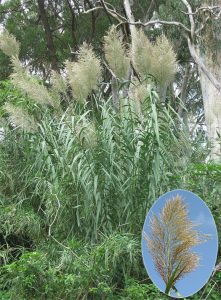BOTANICAL NAME: Arundo donax
FAMILY: Graminae
Classical Classification
Sushrut- Trinpanchmoola
Bhav Prakash– Guduchyadivarga
ENGLISH NAME: Great Reed

REFERENCE: BHAVAPRAKASH SAMHITA with link e Nighantu:
https://niimh.nic.in/ebooks/e-Nighantu/bhavaprakashanighantu/?mod=read
नलः पोटगलः शून्यमध्यश्च धमनस्तथा |
नलस्तु मधुरस्तिक्तः कषायः कफरक्तजित् |
उष्णो हृद्बस्तियोन्यर्तिदाहपित्तविसर्पहृत् ||१३६
HABITAT: Downward Himalya from kashmir to Assam, Nepal.
BOTANICAL DESCRIPTION: A tall reed with hollow stem, perennial reed grass, 6 -12 feet high. Leaves: Tapering from base .Axis of spikelet is enlongate, glabrous Flowering : Silky hairy Panicle thyrisiform.
AYURVEDIC CHARACTERISTICS
| RASA | GUNA | VEERYA | VIPAKA | PRABHAVA | DOSHGHNTA |
| Madhur
Kashae Tikat |
Laghu
Snigdh |
Sheeth | Madhur | Vata Pitta Shamak |
AYURVEDIC ENERGETICS
| TASTE | PROPERTY | POTENCY | POST DIGESTIVE
EFFECT |
EFFECT ACTION | DOSHA ACTION |
| Astingent
Bitter |
Light
Slimy |
Cold | Sweet | Pacifying Vata Pitta |
MAJOR CHEMICAL CONSTITUENTS: Donaxine, Donaxerine
THERAPEUTIC USES
- Wound-The paste of the root is mixed with paste of neem leaf and applied over wound.
- Dysuria-Cold infusion of the root is given in a dose of 50 ml
- Eczema-The paste of the root of nala is applied over the area of the skin.
INDICATION:
VastiShoola Abdominal colic pain, Daha Burning sensation, Mutrakricha Dysuria, Visarpa Herpes, Yoni shool vaginal pain.
USEFUL PART: Mool
DOSAGE: 50- 100 ml (kwath)
AYURVEDIC FORMULATION:
1 Trinpanchmol
2 Panchtrinsheer
